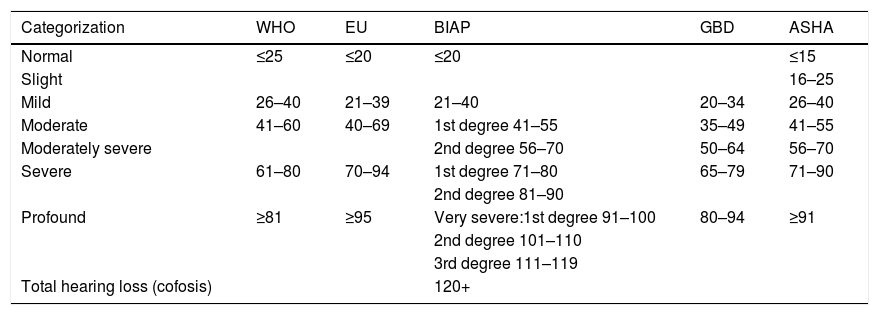Presbycusis or age-related hearing loss is a bilaterally symmetric sensorineural hearing loss associated exclusively with age, excluding any other causes of hearing loss. Presbycusis is very relevant because of its high prevalence, and its consequences (e.g., alterations in communication, social isolation, depression, dementia), and the economic impact. This paper reports the first attempt to estimate the prevalence of presbycusis in an otologically normal population, i.e., without previous ear disease, exposure to noise, or potentially ototoxic substances, or familial hearing loss.
MethodsA total of 4290 subjects from 5 to 90 years old were included in the study.
ResultsNo statistically significant differences were found between right and left ear, nor between males and females, in any of the age groups. Presbycusis was detected over 60 years following the WHO classification; although the results vary depending on the classification used. Moderate hearing loss (≥ 41dB) was detected in the population over 72 years. None of the subjects had severe or profound hearing impairment. The prevalence of presbycusis increased with age, being 100% in individuals aged 80 years and older. The prevalence of presbycusis is highly variable depending on the pure-tone averaged frequencies and the classification system used; therefore, a common classification system should be used.
ConclusionsAn otologically normal population is needed to establish the prevalence of presbycusis as in non-screened populations it is the hearing level including all types of hearing loss that is measured, but not presbycusis itself.
La presbiacusia o pérdida auditiva relacionada con la edad, es una hipoacusia neurosensorial bilateral y simétrica asociada exclusivamente a la edad. La presbiacusia es muy relevante debido a su alta prevalencia y sus consecuencias (alteraciones en la comunicación, aislamiento social, depresión, demencia) y el impacto económico. Este es el primer trabajo que aporta datos sobre la prevalencia de la presbiacusia en una población otológicamente normal, es decir, sin enfermedad auditiva previa, exposición a ruido o sustancias potencialmente ototóxicas o pérdida de audición familiar.
Material y métodosUn total de 4.290 sujetos de 5 a 90 años de edad fueron incluidos en el estudio.
ResultadosNo se encontraron diferencias entre el oído derecho y el izquierdo, ni entre varones y mujeres. La presbiacusia se detectó a partir de los 60 años siguiendo la clasificación de la OMS, aunque los resultados varían dependiendo de la clasificación utilizada. Se detectó hipoacusia moderada (≥41dB) en la población mayor de 72 años. Ninguno de los sujetos tenía hipoacusia grave o profunda. La prevalencia de presbiacusia aumentó con la edad, siendo del 100% en individuos de 80 años o más. La prevalencia de la presbiacusia es altamente variable dependiendo de las frecuencias promediadas y del sistema de clasificación utilizado; por lo tanto, debería utilizarse un sistema de clasificación común.
ConclusionesPara establecer la prevalencia de la presbiacusia se necesita una población otológicamente normal ya que, si la población no está cribada, lo que se mide es la hipoacusia que incluye todos los tipos de pérdida auditiva, pero no la presbiacusia de forma aislada.








